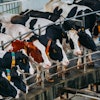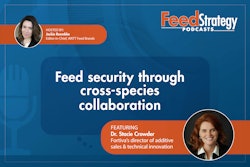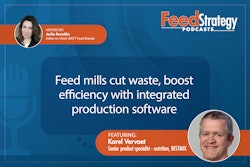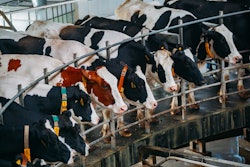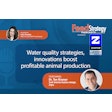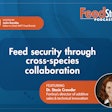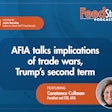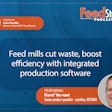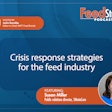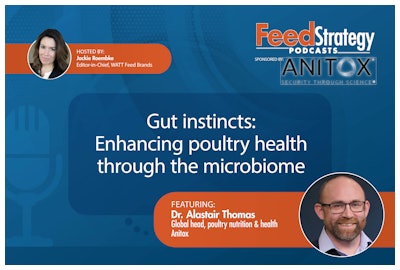
Microbiome management in the first seven days of a bird's life can have lasting impacts on health, productivity and sustainability in poultry production.
Dr. Alastair Thomas, global head of poultry nutrition and health with Anitox, believes that understanding and optimizing the poultry gut microbiome is crucial for modern producers facing challenges in a post-antibiotic growth promoter era. In this conversation, Thomas emphasizes the importance of tailored solutions that address specific microbial challenges and the critical nature of management practices during a chick's first week of life. By focusing on microbiome health, producers can achieve significant improvements in feed efficiency, bird welfare and overall sustainability.
Transcript of interview with Dr. Alastair Thomas, global head of poultry nutrition and health, Anitox
Jackie Roembke, editor-in-chief of WATT's Feed Brands and Feed Strategy Magazine: Hi everyone. Welcome to Feed Strategy Podcast. I'm your host, Jackie Roembke, editor-in-chief of WATT's Feed Brands and Feed Strategy Magazine. This edition of Feed Strategy Podcast is brought to you by Anitox, a global leader in pathogen control and feed safety solutions.
Today, we're joined by Dr. Alastair Thomas, global head of poultry nutrition and health with Anitox. He's here to examine how optimization of the poultry microbiome leads to better growth performance and reduced feed costs.
Hi, Dr. Thomas. How are you today?
Dr. Alastair Thomas, global head of poultry nutrition and health, Anitox: Very good, Jackie. Thanks.
Roembke: Thank you so much for taking the time to speak with me. Let's get right into it. Why don't you tell us about yourself and your background?
Thomas: Sure. I'm based here in the U.S., just outside Philadelphia. From the U.K., originally. Ph.D. in microbiology. And so I've been serving the poultry industry for the last 15 years and in sales and technical capacities, focusing on disease management and how bacteria can really influence the chicken and its productivity.
Roembke: Now, what are we talking about when we discuss the poultry microbiome, and why does that matter in poultry production?
Thomas: You've got to think of the microbiome really as an ecosystem that lives within the animal. It's a population of multiple bacterial species which really interact with the host and themselves to really drive a lot of the gut environment and how the bird reacts to the nutrition and the various other factors in the environment that can influence the health and well-being of the animal.
Roembke: What specific methods or practices can poultry producers use to optimize the gut microbiome?
Thomas: There's a lot of options out there, Jackie, now. Traditionally antibiotics played a very big role in modulating that microbiome — through gut promotion, you've got to remember antibiotics are also used for managing animal health.
They have a positive sustainability message — and they're there to help the animal be healthier through its life. But in the absence of some of those tools, there's lots of options. There are essential oils, there's nutraceuticals, there's probiotics, there's organic acids, and sometimes this can be quite overwhelming.
For your veterinarians or your nutritionists out in the field, you know that they've got a very small amount of time to think about some of these solutions sometimes. So really helping them better understand how, what their problem is at a gut level, at a microbiology level, will then influence how you choose your solution.
There are suppliers out there or products out there which claim to do everything for the gut. I think I found that in my experience, if you look to tackle a particular specific challenge for the producer, you've got a much better chance of success rate. So really tailoring your solution to the problem is beneficial.
There are so many ways that the bird's health can be impacted from its environment, whether that's from the mother, from the hen itself and how she's managed and her general health that impacts on how the young chick is really set up. It really impacts how the microbiome is established early on, on its growth curve and how it grows to market weight most efficiently as possible. And so monitoring things like breeder health and your hatchery contamination potentially all will determine the success of your growing bird further on.
Once that bird's in its environment, when it's in that poultry house, good management is by far the biggest influencer on the chick success — more so than any additive that you can think of. And so that's fundamental, I think, good management and a good understanding of those different things.
In the bird environment, that can influence pathogen infection of the birds, things like feed are a major source. Things like water, better biosecurity as walking in and out of the poultry houses, rodent control, insect control — all these things can have a major impact on the bird through transmission of pathogens.
So really understanding that as good poultry growers do is really the biggest step that they can take in helping mitigate some of these challenges.
Jackie Roembke: Recently at VIV Asia you presented at the Feed Strategy Conference. One interesting point that you made, I'd like you to share with the audience. Will you tell us a little bit more about how important the first seven days of the bird's life are and those longer-term impacts?
Thomas: Absolutely. And I think, your poultry growing, your poultry production company fundamentally knows that you can make or break the growth of that animal.
In those first seven days, it's a very sensitive time for the chick. It is an area of a time of high stress and maternal antibodies reduce, and they start developing their own gut immunology that's very naive at that point in the bird's life and not fully developed. It's very susceptible in those first seven days to overgrowth of particularly pathogenic bacteria species, like E. coli, particularly take significant advantage in the early chick life.
As the microbiome develops through the life of that bird, it becomes more robust. It becomes more of a core microbiome, which reaches almost a steady state, but you have a lot of flux in that early stage of the bird's life between these populations of bacteria, which can be encouraged to move in a positive direction, which will really get the bird on the proper growth curve for success.
You can have it move in a different direction where the growth is impacted through poorer digestibility, bad maturation of the gut or just straight pathogen infection can all make sure that bird is going to be really struggling to get back up to optimal growth rates later in life if you don't get that fundamental seven days really optimized for productivity.
Roembke: How effective is the microbiome and microbiome optimization in reducing antibiotic use, and is it possible that it could ever replace antibiotics altogether?
Thomas: I think that's going to be a big challenge, Jackie.
I think the more that we learn about the overall microbiome, almost as an individual organ. In the bird's gut. I think the more we understand that role, the better we can optimize. Not looking at perhaps the individual species present in the microbiome but seeing that the holistic population and that impact and how it interacts with the bird.
For acute disease problems and clinical disease issues, antibiotics are still the best solution. But I think increasingly feed additives of a nonclinical nature have an important role. And you've seen really over the last five to 10 years, certainly as antibiotic growth promoters were initially removed in the U.S. market, for example.
There was a lot of challenges around understanding how to combine these nutritional additives and which is the best combination to support that bird in the absence of antibiotics. And I've really seen in the last years producers have really got a better understanding of which combinations work.
When to use them, when not to use them, they'll have an antibacterial program of feed additives as well as an anti-coccidial program which they run separately and they're a bit more targeted perhaps around the time of use. When the disease burden is probably lower in the summer months, they can really step back from some of the antibiotic products and really start using some of these nutritional programs. But then coming into the winter months when the disease challenge is higher, the colder-weather houses are closing. Litter is probably a bit wetter in those months, and they tend to lean more on the pharmaceutical products then. There's a rotational strategy that I think producers have really moved to which can be effective.
Ultimately when the birds have a significant challenge, and I'm sure all the veterinarians out there will agree with me, you must step in with some antibiotic solutions to really control that disease.
Roembke: What challenges do poultry producers typically face when they're attempting to optimize their flock’s microbiome, and how can they overcome these hurdles?
Thomas: I think the biggest challenge is not one solution works for every bird and because the nature of the different environments that you'll see even in a poultry house but certainly between poultry houses.
Between complexes and between producers, you see a tremendous variety of microbiological environments. That means that each individual bird has a slightly different microbiome. There's largely generous or family level similarities, but there's a very diverse population, even from one bird in a poultry house to another and then using a certain solution to address a certain problem. And it makes it even more challenging because that gut microbiota, that fundamental population can significantly differ. And consequently, not all the solutions can work at the same time. And so, the biggest challenge is what to use when and then.
The other challenge I get this from producers quite a lot of the time is how do we know it's working? Sometimes if you are using these solutions to control the microbiome in a prophylactic manner, to prevent any disease, if you, it's very difficult sometimes to prove a negative if you don't get the disease.
Is the product working or was the disease challenge not even there? I found by really partnering with the producer in the field, taking the right level of sampling, whether that be from the feed litter swabbing the birds, sampling the birds directly.
It's only when you get down to that microbiologic level. With that kind of field testing, you can really see what the challenge is and that your solution is working because ultimately, we're talking about variations in performance in which is very difficult to pick up across 150 farms in a poultry complex, for example.
And there's a lot of variability across those different populations. And so minor differences are a big challenge to be picked up in the field sometimes, and that makes it even harder then to see if your solutions are really working at a level that you hope they are.
Roembke: What measurable benefits have you seen in poultry health, productivity and sustainability while working to optimize the microbiome?
Thomas: I'm a big believer that 70%, at least, of the greenhouse gas emissions in poultry come from feed and feed production. So, any solution you are using in the poultry life cycle that reduces feed usage has a significant impact on the overall sustainability output of production.
And so, I believe that, if you have a less-than-optimal microbiome, your bird's gut health or performance is not optimal due to those challenges. By using some of these solutions and treating some of your environments and treating your feed, you can improve the performance. Ultimately, you are getting the chickens to market way earlier or you are getting the chickens to market weight using less feed. Overall, that sustainability benefit is by reducing the amount of feed needed to get to that point in the production process that has a defined impact on things like greenhouse gas emission.
I think another important piece of sustainability there is welfare as well. A healthy gut, a healthy bird, a happy bird will be much more much more productive. And an optimized microbiome will drive some of those welfare indicators. You'll have a healthier bird, which means less disease. Healthier bird means less litter challenges, so you'll have better quality of litter, which is going to be less impact on the footpad.
It's going to be a better environment for the respiration of the bird as well. I think optimizing your use of feed, less feed for more pounds of chicken is a very sustainable practice as well as managing that welfare and that environment of the bird.
Roembke: Switching gears a little bit, let's talk about feed safety and biosecurity. Are there any takeaways you'd like feed producers to keep in mind?
Thomas: As I mentioned earlier, there's lots of vectors for the, potentially, for pathogens to enter the production chain. That can be viruses like avian influenza, avian metapneumoviruses, that can be bacterial challenge through E. coli, through Clostridium. There's lots of potential.
In the production process from contamination with pathogens and feed is certainly a recognized vector potentially for pathogens into the production chain. We know from research that corn and soy, which are, major components of diets globally and poultry production can have higher levels of Salmonella, Enterobacter and other pathogens on them. And so being mindful of your feed hygiene is really helping you control one of those important potential vectors for disease in the bird. I know there's various other elements of good practice and good welfare.
And good management that can contribute. But certainly, feed is a recognized vector for disease providing as many hurdles to that pathogen to the bird is a very important step as part of your critical control plans, I really think feed needs to be addressed, managed to minimize the impact that any of these pathogens can have on that optimal growth of your bird.
Jackie Roembke: Anything else that we haven't touched on that you'd like to share?
Thomas: From a supplier standpoint and for the poultry producers, let's focus more on that early bird. I believe there's lots of opportunities in treatments later in the age of the bird in the grower diets and in the finisher diets, but as I said, to really optimize your production, performance, making sure that early bird, that seven days, is the most important in the bird's life.
And I think as an industry we could do better at focusing on that. And that comes from managing the hen as well as managing that early chick. And I think a bit more focus in the research around that area and how we really can help producers optimize those early days. I think that's going to produce a lot of benefits further down the line for both the industry and the birds itself.
Roembke: If you'd like more information about Anitox and its solutions, please visit www.anitox.com. Thank you again, Dr. Thomas, and thanks to you for tuning in.
